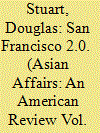| Srl | Item |
| 1 |
ID:
112744


|
|
|
|
|
| Publication |
2012.
|
| Summary/Abstract |
This article surveys some of the challenges that President Obama or his successor
will face over the next several years as the United States attempts to "pivot
toward Asia." In view of the ongoing shift in power from West to East, Washington
can no longer assume that it can preserve or transform Asia-Pacific security by its
unilateral actions. Rather, the United States must develop a "lead from behind"
strategy that will assist America's Asia-Pacific friends and allies to "make room
for China" while at the same time encouraging them to take greater responsibility
for regional security. As it develops its plans for the Asia-Pacific region, the
United States will have to accord special attention to three legacy issues (the
China-Taiwan relationship, the unresolved confrontation between North and
South Korea, and the incompatibility of American and Chinese values) which
have confounded U.S.-China relations for six decades. If managed properly, a
U.S. pivot toward Asia can be beneficial to both the United States and America's
regional friends and allies. But this will require Washington to pursue what President
Obama recently described as a "more centered course" that leverages America's
assets in the Asia-Pacific while avoiding policies that force regional governments
to choose between Washington and Beijing.
|
|
|
|
|
|
|
|
|
|
|
|
|
|
|
|
| 2 |
ID:
062306


|
|
|
|
|
| Publication |
Winter 2004-05.
|
|
|
|
|
|
|
|
|
|
|
|
|
|
|
|
| 3 |
ID:
117651


|
|
|
|
|
| Publication |
2012.
|
| Summary/Abstract |
This is the third time that American policy makers have considered a pivot to Asia. This time is different, however, because it is clear that the base of gravity of the global economy is shifting from West to East. As the most powerful nation in the Asia-Pacific, the United States has an overriding national interest in the preservation of regional prosperity and order. But Washington recognizes that it can no longer impose solutions on the major governments in the region. A new U.S. strategy for the Asia-Pacific will have to take into account the very strict limits imposed on U.S. foreign and defense policies by America's relative economic decline. This means that Washington will have to convince its friends and allies to take greater responsibility for regional security. The so-called San Francisco system of U.S.-sponsored alliances will have to be transformed, in order to make it more responsive to the problems that confront America and its regional friends and allies. This essay will draw upon Joseph Nye's concept of ideal and material resources to assess the viability and adaptability of the San Francisco system. It will also consider the merits of the Pentagon's proposed AirSea Battle concept as a response to Chinese military modernization and as a source of reassurance for Washington's regional friends and allies.
|
|
|
|
|
|
|
|
|
|
|
|
|
|
|
|